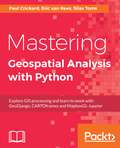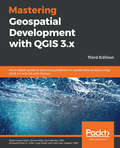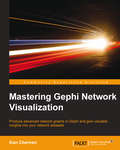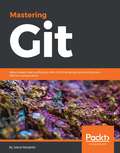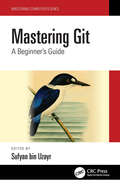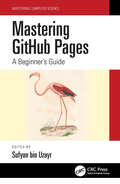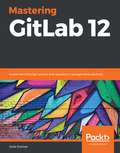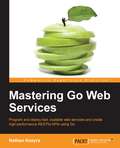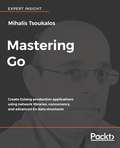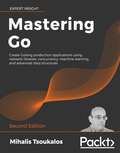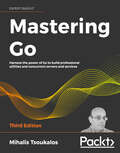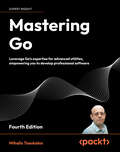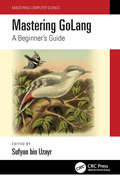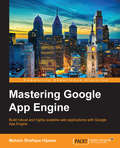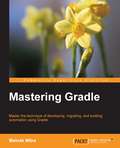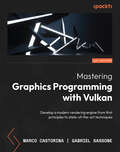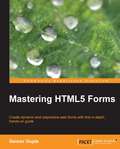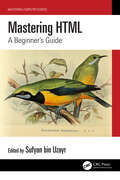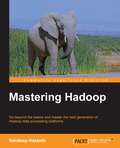- Table View
- List View
Mastering Geospatial Analysis with Python: Explore GIS processing and learn to work with GeoDjango, CARTOframes and MapboxGL-Jupyter
by Silas Toms Paul Crickard Eric Van ReesExplore GIS processing and learn to work with various tools and libraries in Python. Key Features Analyze and process geospatial data using Python libraries such as; Anaconda, GeoPandas Leverage new ArcGIS API to process geospatial data for the cloud. Explore various Python geospatial web and machine learning frameworks.Book DescriptionPython comes with a host of open source libraries and tools that help you work on professional geoprocessing tasks without investing in expensive tools. This book will introduce Python developers, both new and experienced, to a variety of new code libraries that have been developed to perform geospatial analysis, statistical analysis, and data management. This book will use examples and code snippets that will help explain how Python 3 differs from Python 2, and how these new code libraries can be used to solve age-old problems in geospatial analysis.You will begin by understanding what geoprocessing is and explore the tools and libraries that Python 3 offers. You will then learn to use Python code libraries to read and write geospatial data. You will then learn to perform geospatial queries within databases and learn PyQGIS to automate analysis within the QGIS mapping suite. Moving forward, you will explore the newly released ArcGIS API for Python and ArcGIS Online to perform geospatial analysis and create ArcGIS Online web maps. Further, you will deep dive into Python Geospatial web frameworks and learn to create a geospatial REST API.What you will learn Manage code libraries and abstract geospatial analysis techniques using Python 3. Explore popular code libraries that perform specific tasks for geospatial analysis. Utilize code libraries for data conversion, data management, web maps, and REST API creation. Learn techniques related to processing geospatial data in the cloud. Leverage features of Python 3 with geospatial databases such as PostGIS, SQL Server, and SpatiaLite.Who this book is forThe audience for this book includes students, developers, and geospatial professionals who need a reference book that covers GIS data management, analysis, and automation techniques with code libraries built in Python 3.
Mastering Geospatial Development with QGIS 3.x: An in-depth guide to becoming proficient in spatial data analysis using QGIS 3.4 and 3.6 with Python, 3rd Edition
by Shammunul Islam Simon Miles GISP Menke GISP Smith Jr. Luigi Pirelli John Van Hoesen, GISP,Go beyond the basics and unleash the full power of QGIS 3.4 and 3.6 with practical, step-by-step examples Key Features One-stop solution to all of your GIS needs Master QGIS by learning about database integration, and geoprocessing tools Learn about the new and updated Processing toolbox and perform spatial analysis Book Description QGIS is an open source solution to GIS and widely used by GIS professionals all over the world. It is the leading alternative to proprietary GIS software. Although QGIS is described as intuitive, it is also, by default, complex. Knowing which tools to use and how to apply them is essential to producing valuable deliverables on time. Starting with a refresher on the QGIS basics and getting you acquainted with the latest QGIS 3.6 updates, this book will take you all the way through to teaching you how to create a spatial database and a GeoPackage. Next, you will learn how to style raster and vector data by choosing and managing different colors. The book will then focus on processing raster and vector data. You will be then taught advanced applications, such as creating and editing vector data. Along with that, you will also learn about the newly updated Processing Toolbox, which will help you develop the advanced data visualizations. The book will then explain to you the graphic modeler, how to create QGIS plugins with PyQGIS, and how to integrate Python analysis scripts with QGIS. By the end of the book, you will understand how to work with all aspects of QGIS and will be ready to use it for any type of GIS work. What you will learn Create and manage a spatial database Get to know advanced techniques to style GIS data Prepare both vector and raster data for processing Add heat maps, live layer effects, and labels to your maps Master LAStools and GRASS integration with the Processing Toolbox Edit and repair topological data errors Automate workflows with batch processing and the QGIS Graphical Modeler Integrate Python scripting into your data processing workflows Develop your own QGIS plugins Who this book is for If you are a GIS professional, a consultant, a student, or perhaps a fast learner who wants to go beyond the basics of QGIS, then this book is for you. It will prepare you to realize the full potential of QGIS.
Mastering Gephi Network Visualization
by Ken ChervenThis book is intended for anyone interested in advanced network analysis. If you wish to master the skills of analyzing and presenting network graphs effectively, then this is the book for you. No coding experience is required to use this book, although some familiarity with the Gephi user interface will be helpful.
Mastering Git
by Jakub NarebskiAttain expert-level proficiency with Git for enhanced productivity and efficient collaboration by mastering advanced distributed version control features About This Book * Set up Git for solo and collaborative development * Harness the full power of Git version control system to customize Git behavior, manipulate history, integrate external tools and explore platform shortcuts * A detailed guide, which explains how to apply advanced Git techniques and workflows and ways to handle submodules Who This Book Is For If you are a Git user with reasonable knowledge of Git and familiarity with basic concepts such as branching, merging, staging, and workflows, this is the book for you. Basic knowledge of installing Git and software configuration management concepts is essential. What You Will Learn * Explore project history, find revisions using different criteria, and filter and format how history looks * Manage your working directory and staging area for commits and interactively create new revisions and amend them * Set up repositories and branches for collaboration * Submit your own contributions and integrate contributions from other developers via merging or rebasing * Customize Git behavior system-wide, on a per-user, per-repository, and per-file basis * Take up the administration and set up of Git repositories, configure access, find and recover from repository errors, and perform repository maintenance * Chose a workflow and configure and set up support for the chosen workflow In Detail Git is one of the most popular types of Source Code Management (SCM) and Distributed Version Control System (DVCS). Despite the powerful and versatile nature of the tool enveloping strong support for nonlinear development and the ability to handle large projects efficiently, it is a complex tool and often regarded as "user-unfriendly". Getting to know the ideas and concepts behind the architecture of Git will help you make full use of its power and understand its behavior. Learning the best practices and recommended workflows should help you to avoid problems and ensure trouble-free development. The book scope is meticulously designed to help you gain deeper insights into Git's architecture, its underlying concepts, behavior, and best practices. Mastering Git starts with a quick implementation example of using Git for a collaborative development of a sample project to establish the foundation knowledge of Git operational tasks and concepts. Furthermore, as you progress through the book, the tutorials provide detailed descriptions of various areas of usage: from archaeology, through managing your own work, to working with other developers. This book also helps augment your understanding to examine and explore project history, create and manage your contributions, set up repositories and branches for collaboration in centralized and distributed version control, integrate work from other developers, customize and extend Git, and recover from repository errors. By exploring advanced Git practices, you will attain a deeper understanding of Git's behavior, allowing you to customize and extend existing recipes and write your own. Style and approach Step-by-step instructions and useful information make this book the ultimate guide to understanding and mastering Git. This book will show road to mastery example by example, while explaining mental model of Git. The Introduction section covers the 'Essentials' just for refreshing the basics. The main highlight is that the concepts are based on HOW the technology/framework works and not just practical 'WHAT to do'.
Mastering Git: A Beginner's Guide (Mastering Computer Science)
by Sufyan Bin UzayrMastering Git: A Beginner’s Guide introduces developers of all ages to the wonderful and useful world of Git. As far as software development is considered, the advent of Git has truly proven to be a milestone. If you are a software developer, you have probably already heard of Git. Its importance and functionality in the world of coding merits very high praise for a variety of reasons. Computers now have become very amenable machines. You can remove a significant section of the text from your work accidentally, but there is no need to panic. Simply use the Undo option and you’re good. This, however, was not the case in the early days of development. Back then, developers did not have access to any such technology, and it was only one person who used to own the master copy of a work. This person would divide the code into specific parts, which would subsequently be divided between developers, who would work on their part and make their completed submissions independent of each other. This was followed by a standard check, after which the old version was completely replaced by the new version. This was a very tedious process—unless someone had beenvery proactive with making copies of the code, the previous versions of a file were often effectively lost. Thankfully, a significant breakthrough came in 1972 when developer Marc Rochkind invented the Source Code Control System (SCCS), which was the very first form of Version Control System (VCS). It was limited in terms of its functionality, and could allow only one person to work on it at a time, while concurrent management had to be handled using locks. But we have come a long way since then. Today, Git is the single most-used VCS out there. Its influence on coding and development, in particular, the innovative use of "branches" in order to facilitate collaboration for projects, cannot be over-emphasized. Version Control has become an indispensable part of our lives, and being familiar with the functioning of Git is something employers deem highly important. Mastering Git will prove to be of tremendous help to developers of all spheres in learning Git and Version Control. This book offers information on a wide array of subjects pertaining to Git, and even briefly touches upon its history, advantages, and disadvantages. Mastering Git also offers tips on installation and different elements involved in its functioning, such as Repositories, Remotes, Aliases, Tagging, and Branches. Popular services and hosts for such Git projects as GitHub, GitLab, and Bitbucket are also discussed in detail. This book will prove to be a handy guide for both newbie learners and trained professionals. Learn more about our other Mastering titles at: https://www.routledge.com/Mastering-Computer-Science/book-series/MCS
Mastering Git: Attain expert-level proficiency with Git by mastering distributed version control features
by Jakub NarębskiHarness the full power of the Git version control system, gaining insights into Git best practices and strengthening your understanding of its architecture, underlying concepts, and behaviorKey FeaturesSet up Git for solo and collaborative development as well as for code, documentation, configuration, or dataLeverage the Git version control system to customize and extend existing recipes, and write your ownDiscover how to efficiently manage large and complex repositoriesPurchase of the print or Kindle book includes a free PDF eBookBook DescriptionDevelopers often feel overwhelmed by complex version control issues, especially when managing large repositories. This updated second edition of our Git guide empowers you to tackle these challenges head-on and emerge as a Git pro. The book gets you up to speed with the latest Git version, its features, and advanced branching techniques, helping you master complex development scenarios. A new chapter on tackling challenges while managing large repositories has been added, providing invaluable strategies for efficient version control with Git. The book goes beyond the basics to take you through Git’s architecture, behavior, and best practices in depth. The chapters help you develop a clear understanding of customizing workflows, creating unique solutions, and tackling any version control hurdle. As you advance, you’ll explore a wide range of functionalities, from examining project history to collaborating seamlessly with teammates. Detailed descriptions guide you through managing your work, collaborating with others, administering Git, and navigating project history. By the end of this book, you’ll have become a Git pro and be confident enough to handle advanced branching, manage large repositories, customize workflows, collaborate effectively, and troubleshoot any version control issues.What you will learnExplore project history and find revisions using different criteria Manage your working directory and staging area Set up repositories and branches for collaboration Configure and set up support for the chosen workflow Submit your own contributions and integrate contributions made by others Customize Git behavior system-wide, from per-user to per-file basis Perform Git administration to set up and manage repositories Who this book is forThis book is for developers looking to elevate their Git skills beyond the basics. Whether you're a seasoned developer or just getting started with version control, this book will help you leverage Git for efficient collaboration, code management, and improved workflows. The book also equips DevOps professionals with the knowledge they need to configure Git for seamless integration within DevOps workflows, enabling smoother collaboration between development and operations teams.
Mastering GitHub Enterprise Management and Administration: A Guide for Seamless Management and Collaboration
by Balu Nivrutti Ilag AjayKumar P. Baljoshi Ganesh J. Sangale Yogesh AthaveThis book is a comprehensive guide to GitHub Enterprise Cloud and provides a detailed overview of how to set up, manage, administer, and configure GitHub for organizations. In addition to this, you will also learn identity management and the CI/CD pipeline.The book starts with a thorough introduction to GitHub administration and its benefits. You will then learn how to set up and manage a GitHub Enterprise account and organization, guiding administrators through each step. Next, you will go through GitHub Repository Secure Management and Best Practices along with an understanding of how to manage access to GitHub using SAML SSO. GitHub enterprise support strategies and their usage and adoption are discussed next in detail. Moving ahead, you will learn about GitHub Action and Packages followed by GitHub Copilot management. How to automate repetitive tasks and workflows using GitHub Actions and enhancing productivity is discussed in detail with the help of case studies. Towards the end, you will demonstrate securing the software development lifecycle through advanced security and use GitHub Actions for automating business processes.After reading this book, you will be able to leverage the full potential of GitHub Enterprise Cloud for your software development needs.What Will You LearnHow to set up and configure GitHub Enterprise for optimal collaboration, security, and scalability in an enterprise environment.Best practices for managing organizations, repositories, and user access permissions effectively to foster efficient teamwork and code collaboration.Strategies to implement robust CI/CD pipelines using GitHub Actions, automating build, testing, and deployment processes for faster and more reliable software delivery.Proven techniques for ensuring top-notch security and compliance, including authentication methods, access controls, and vulnerability scanning, to protect code repositories and sensitive data.Who Is This Book ForSoftware Development teams, DevOps engineers, and IT professionals who are looking to use GitHub Enterprise Cloud for code collaboration, management, and deployment.
Mastering GitHub Pages: A Beginner's Guide (Mastering Computer Science)
by Sufyan Bin UzayrWhy should you read Mastering GitHub Pages: A Beginner’s Guide? Because this book offers you a concise guide so that you can quickly navigate the terrains of GitHub Pages sites in a fairly smooth manner. But why use GitHub Pages if it can only make static websites? Why should you go for static websites when you could get a dynamic one made for your organization? Again, why not?! Having a static website is a sure-shot strategy to save a lot of money, keep the website secure, and ensure built-in backups. In addition, you can serve it over HTTPS and make sure that it is fast and SEO-ready. Mastering GitHub Pages delves into static (and dynamic) websites as well as their advantages and disadvantages. Static websites tend to be incredibly fast since they have no processing time for databases and other stuff. Additionally, because you are committing a code base of static assets to a Git repository, the rolling back of changes is simply an issue involving reversion to a commit that was made previously. So backups are a mere git push away, and you are basically serving your entire website from a cache. This means that your server will never need to process a request again. This book helps you master the art of static site generation in no time. Furthermore, Mastering GitHub Pages also discusses in great length Jekyll, a popular static site generator. When working with Jekyll, all you do is give it liquid templates as well as Markdown content, and it is adept at combining them both into a static website. It requires no-on-the-fly processing, and your blog will display at a significantly faster speed. This workflow proves useful for GitHub Pages because they tend to support the Jekyll builds. As such, your blog posts can be contributed using pull requests, and all your content gets stored within version control. Non-developers could also contribute posts in Markdown. Mastering GitHub Pages is an immensely useful book that all developers can use for the creation of websites on the free GitHub Pages platform. So, go ahead, grab a copy of the book for a proper GitHub Pages primer! Learn more about our other Mastering titles at: https://www.routledge.com/Mastering-Computer-Science/book-series/MCS
Mastering GitLab 12: Implement DevOps culture and repository management solutions
by Joost EvertseAn expert guide to helping you use DevOps techniques with the latest GitLab version to optimize and manage your software workflow Key Features Delve into GitLab's architecture, and install and configure it to fit your environment Learn about the underlying principles of Agile software development and DevOps Explore Gitlab's features to manage enterprise cloud-native applications and services Book Description GitLab is an open source repository management and version control toolkit with functions for enterprises and personal software projects. It offers configurability options, extensions, and APIs that make it an ideal tool for enterprises to manage the software development life cycle. This book begins by explaining GitLab options and the components of the GitLab architecture. You will learn how to install and set up GitLab on-premises and in the cloud, along with understanding how to migrate code bases from different systems, such as GitHub, Concurrent Versions System, Team Foundation Version Control, and Subversion. Later chapters will help you implement DevOps culture by introducing the workflow management tools in GitLab and continuous integration/continuous deployment (CI/CD). In addition to this, the book will guide you through installing GitLab on a range of cloud platforms, monitoring with Prometheus, and deploying an environment with GitLab. You'll also focus on the GitLab CI component to assist you with creating development pipelines and jobs, along with helping you set up GitLab runners for your own project. Finally, you will be able to choose a high availability setup that fits your needs and helps you monitor and act on results obtained after testing. By the end of this book, you will have gained the expertise you need to use GitLab features effectively, and be able to integrate all phases in the development process. What you will learn Install GitLab on premises and in the cloud using a variety of configurations Conduct data migration from the SVN, TFS, CVS, and GitHub platforms to GitLab Use GitLab runners to develop different types of configurations in software development Plan and perform CI/CD by using GitLab features Monitor and secure your software architecture using Prometheus and Grafana Implement DevOps culture by introducing workflow management tools in GitLab Who this book is for If you are a software developer, DevOps professional, or any developer who wants to master GitLab for productive repository management in your day-to-day tasks, this book is for you. Basic understanding of the software development workflow is assumed.
Mastering Go Web Services
by Nathan KozyraIf you are a web programmer with experience in developing web services and have a rudimentary knowledge of using Go, then this is the book for you. Basic knowledge of Go as well as knowledge of relational databases and non-relational NoSQL datastores is assumed. Some basic concurrency knowledge is also required.
Mastering Go: Create Golang Production Applications Using Network Libraries, Concurrency, And Advanced Go Data Structures
by Mihalis Tsoukalos<P><P>Exploring the major features and packages of Go, along with its types and data-structures, enabling the reader to write threadsafe, concurrent cloud, and network applications <P><P>Key Features <P><P>Not your typical introduction to the Golang programming language <P><P>Exploring Golang cradle to grave, completes the developer's Golang education <P><P>A thorough exploration into the core libraries and Golang features, that usually are taken for granted <P><P>In depth explanation, detailing the rationale behind composite data types, Golang concurrency, and the Golang networking library <P><P>Book Description <P><P>Often referred to as Golang (albeit wrongly), the Go programming language is really making strides thanks to some masterclass developments, architected by the greatest programming minds. Shopify CEO Tobias Lutke has been recently quoted as saying “Go will be the server language of the future.” Go programmers are in high demand, but - more controversially - Go takes the stage where C and Unix programmers previously led the way. <P><P>The growth of the Go language has seen it become the means by which systems, networking, web, and cloud applications are implemented. If you're a Go programmer, you'll already know some Go syntax and will have written some small projects. However, most Go programmers face the difficulty of having to integrate their Golang skills with production code. With Mastering Go, the author shows you just how to tackle this problem. You'll benefit by mastering the use of the libraries and utilize its features, speed, and efficiency for which the Go ecology is justly famous. <P><P>Offering a compendium of Go, the book begins with an account of how Go has been implemented. You'll also benefit from an in-depth account of concurrency and systems and network programming imperative for modern-day native cloud development through the course of the book. <P><P>What you will learn <P><P>Understand the design choices of Golang syntax <P><P>Know enough Go internals to be able to optimize Golang code <P><P>Appreciate concurrency models available in Golang <P><P>Understand the interplay of systems and networking code <P><P>Write server-level code that plays well in all environments <P><P>Understand the context and appropriate use of Go data types and data structures <P><P>Who this book is for <P><P>This book is for Golang programmers. You should have previously read an introductory book on Go, or to have worked through the Tour of Go or an equivalent online course. This book will definitely help to remember the basic concepts of concurrency, but network programming will be explained. A certain amount of previous coding and production experience would be helpful.
Mastering Go: Create Golang production applications using network libraries, concurrency, and advanced Go data structures
by Mihalis TsoukalosExploring the major features and packages of Go, along with its types and data-structures, enabling the reader to write threadsafe, concurrent cloud, and network applicationsKey Features Not your typical introduction to the Golang programming language Exploring Golang cradle to grave, completes the developer’s Golang education A thorough exploration into the core libraries and Golang features, that usually are taken for granted In depth explanation, detailing the rationale behind composite data types, Golang concurrency, and the Golang networking libraryBook DescriptionThe Go programming language, often referred to as Golang (albeit wrongly), is really making strides, with some masterclass developments, architected by the greatest programming minds. Tobias Lutke, CEO of Shopify, recently quoted as saying “Go will be the server language of the future”, powerful words, with much ambition. Go programmers are in high demand, but more controversially, Go takes the stage, where C and Unix programmers previously led the way.The growth of the Go language has seen it become the means by which systems, networking, web, and cloud applications are implemented. Comfortable with syntax, you’ll benefit by mastering the use of the libraries and utilise its features, speed, and efficiency, for which the Go ecology is justly famous.You already know a little Go syntax and you’ve written some small projects, most Go programmers face the difficulty of having to integrate their Golang skills with production code. Typical introductions to Go programming, often stop short of this transition, the author continue on, showing you just how to tackle this.Offering a compendium of Go, the book begins with an account of how Go has been implemented, also, the reader will benefit from a dedicated chapter, an in-depth account of concurrency, systems and network programming, imperative for modern-day native cloud development. What you will learn Understand the design choices of Golang syntax Know enough Go internals to be able to optimize Golang code Appreciate concurrency models available in Golang Understand the interplay of systems and networking code Write server-level code that plays well in all environments Understand the context and appropriate use of Go data types and data structuresWho this book is forThis book is for Golang programmers. You should have previously read an introductory book on Go, or to have worked through the Tour of Go or an equivalent online course. This book will definitely help to remember the basic concepts of concurrency, but network programming will be explained. A certain amount of previous coding and production experience would be helpful.
Mastering Go: Create Golang production applications using network libraries, concurrency, machine learning, and advanced data structures, 2nd Edition
by Mihalis TsoukalosDive deep into the Go language and become an expert Go developer Key Features Second edition of the bestselling guide to advanced Go programming, expanded to cover machine learning, more Go packages and a range of modern development techniques Completes the Go developer's education with real-world guides to building high-performance production systems Packed with practical examples and patterns to apply to your own development work Clearly explains Go nuances and features to remove the frustration from Go development Book Description Often referred to (incorrectly) as Golang, Go is the high-performance systems language of the future. Mastering Go, Second Edition helps you become a productive expert Go programmer, building and improving on the groundbreaking first edition. Mastering Go, Second Edition shows how to put Go to work on real production systems. For programmers who already know the Go language basics, this book provides examples, patterns, and clear explanations to help you deeply understand Go's capabilities and apply them in your programming work. The book covers the nuances of Go, with in-depth guides on types and structures, packages, concurrency, network programming, compiler design, optimization, and more. Each chapter ends with exercises and resources to fully embed your new knowledge. This second edition includes a completely new chapter on machine learning in Go, guiding you from the foundation statistics techniques through simple regression and clustering to classification, neural networks, and anomaly detection. Other chapters are expanded to cover using Go with Docker and Kubernetes, Git, WebAssembly, JSON, and more. If you take the Go programming language seriously, the second edition of this book is an essential guide on expert techniques. What you will learn Clear guidance on using Go for production systems Detailed explanations of how Go internals work, the design choices behind the language, and how to optimize your Go code A full guide to all Go data types, composite types, and data structures Master packages, reflection, and interfaces for effective Go programming Build high-performance systems networking code, including server and client-side applications Interface with other systems using WebAssembly, JSON, and gRPC Write reliable, high-performance concurrent code Build machine learning systems in Go, from simple statistical regression to complex neural networks Who this book is for Mastering Go, Second Edition is for Go programmers who already know the language basics, and want to become expert Go practitioners.
Mastering Go: Harness the power of Go to build professional utilities and concurrent servers and services, 3rd Edition
by Mihalis TsoukalosMaster key features of Go, including advanced concepts like concurrency and working with JSON, to create and optimize real-world services, network servers, and clientsKey FeaturesThird edition of the bestselling guide to advanced Go programming, expanded to cover RESTful servers, the WebSocket protocol, and Go genericsUse real-world exercises to build high-performance network servers and powerful command line utilitiesPacked with practical examples and utilities to apply to your own development work and administrative tasksClearly explains Go nuances and features to simplify Go developmentBook DescriptionGo is the language of the future for high-performance systems due to its simplicity and clear principles. Mastering Go shows you how to put Go to work on real production systems. This new edition has been updated to include topics like creating RESTful servers and clients, understanding Go generics, and developing gRPC servers and clients. Mastering Go, Third Edition explores the capabilities of Go in practice. You will become confident with advanced concepts, including concurrency and the operation of the Go Garbage Collector, using Go with Docker, writing powerful command-line utilities, working with JavaScript Object Notation (JSON) data, and interacting with databases. You will also improve your understanding of Go internals to optimize Go code and use data types and data structures in new and unexpected ways. This Go programming book also covers the nuances and idioms of Go with exercises and resources to fully embed your newly acquired knowledge. Become an expert Go programmer by building Go systems and implementing advanced Go techniques in your projects.What you will learnUse Go in productionWrite reliable, high-performance concurrent codeManipulate data structures including slices, arrays, maps, and pointersDevelop reusable packages with reflection and interfacesBecome familiar with generics for effective Go programmingCreate concurrent RESTful servers, and build gRPC clients and serversDefine Go structures for working with JSON dataWho this book is forThis book is for Go programmers with previous coding experience, who are familiar with the basics of the language and want to become expert Go practitioners.
Mastering Go: Leverage Go's expertise for advanced utilities, empowering you to develop professional software
by Mihalis TsoukalosDive into the core of Go programming and cover advanced topics like generics, concurrency, web services, and cutting-edge testing techniques in this comprehensive fourth edition.Key FeaturesFully updated with coverage of web services, TCP/IP, REST APIs, Go Generics, and Fuzzy TestingApply your new knowledge to real-world exercises, building high-performance servers and robust command-line utilities, to deepen your learningGain clarity on what makes Go different, understand its nuances and features for smoother Go developmentBook DescriptionMastering Go, now in its fourth edition, remains the go-to resource for real-world Go development. This comprehensive guide delves into advanced Go concepts, including RESTful servers, and Go memory management. This edition brings new chapters on Go Generics and fuzzy Testing, and an enriched exploration of efficiency and performance. As you work your way through the chapters, you will gain confidence and a deep understanding of advanced Go topics, including concurrency and the operation of the Garbage Collector, using Go with Docker, writing powerful command-line utilities, working with JavaScript Object Notation (JSON) data, and interacting with databases. You will be engaged in real-world exercises, build network servers, and develop robust command-line utilities. With in-depth chapters on RESTful services, the WebSocket protocol, and Go internals, you are going to master Go's nuances, optimization, and observability. You will also elevate your skills in efficiency, performance, and advanced testing. With the help of Mastering Go, you will become an expert Go programmer by building Go systems and implementing advanced Go techniques in your projects.What you will learnLearn Go data types, error handling, constants, pointers, and array and slice manipulations through practical exercisesCreate generic functions, define data types, explore constraints, and grasp interfaces and reflectionsGrasp advanced concepts like packages, modules, functions, and database interactionCreate concurrent RESTful servers, and build TCP/IP clients and serversLearn testing, profiling, and efficient coding for high-performance applicationsDevelop an SQLite package, explore Docker integration, and embrace workspacesWho this book is forMastering Go is written primarily for Go programmers who have some experience with the language and want to become expert practitioners. You will need to know the basics of computer programming before you get started with this book, but beyond that, anyone can sink their teeth into it.
Mastering GoLang: A Beginner's Guide (Mastering Computer Science)
by Sufyan Bin UzayrMastering GoLang helps readers quickly understand the core concepts and then move on to practical projects using the Go programming language. GoLang is often dubbed a game-changer in the world of programming languages. Instead of starting from scratch, Go was created using the C programming language. GoLang inherits C’s disciplined grammar but with specific tweaks and enhancements to properly manage memory. This lessens the memory leakage problems that developers tend to face with C. Go borrows and adapts notions from various programming languages while skipping characteristics that result in complicated, insecure, and unpredictable code. Go’s concurrency features are well-suited to build the infrastructure for gigantic projects such as networking systems and distributed hardware. Go is also often employed in domains such as visuals, mobile applications, and Machine Learning. Even though GoLang is a relatively new language, it has been adopted by several major organizations owing to its benefits, which include code clarity, custom libraries, adaptability, multithreading, and a simple build process. Because Go is gaining traction in the development community, learning GoLang can open up new avenues across various fields and career trajectories. Since it is still a relatively newer language, quality literature pertaining to Go is often hard to find. This particular book covers all the bases that you might need, and is an ideal companion for beginner-level developers looking to master Go programming. With Mastering GoLang, learning GoLang becomes an easy task, and learners can use their skills to create innovative projects. The Mastering Computer Science series is edited by Sufyan bin Uzayr, a writer and educator with over a decade of experience in the computing field.
Mastering Google App Engine
by Mohsin Shafique HijazeeBuild robust and highly scalable web applications with Google App Engine About This Book * Get an in-depth look at how Google App Engine works under the hood * Design and model your application around Google's highly scalable distributed NoSQL datastore to unlock its full potential * A comprehensive guide to ensure your mastery of Google App Engine Who This Book Is For If you have been developing web applications in Python or any other dynamic language but have always wondered how to write highly scalable web applications without getting into system administration and other plumbing, then this is the book for you. No experience in writing scalable applications is required. What You Will Learn * Scale and develop your applications with Google App Engine's runtime environment * Get to grips with request handling mechanism and write request handlers * Deep dive into Google's distributed NoSQL and highly scalable datastore and design your application around it * Implement powerful search with scalable datastore * Perform long-running tasks in the background using task queues * Write compartmentalized apps using multi tenancy, memcache, and other Google App Engine runtime services * Handle web requests using the CGI, WSGI, and multi-threaded configurations * Deploy, tweak, and manage apps in production on Google App Engine In Detail Developing web applications that serve millions of users is no easy task, as it involves a number of configurations and administrative tasks for the underlying software and hardware stack. This whole configuration requires not only expertise, but also a fair amount of time as well. Time that could have been spent on actual application functionality. Google App Engine allows you develop highly scalable web applications or backends for mobile applications without worrying about the system administration plumbing or hardware provisioning issues. Just focus writing on your business logic, the meat of the application, and let Google's powerful infrastructure scale it to thousands of requests per second and millions of users without any effort on your part. This book takes you from explaining how scalable applications work to designing and developing robust scalable web applications of your own, utilizing services available on Google App Engine. Starting with a walkthrough of scalability is and how scalable web applications work, this book introduces you to the environment under which your applications exist on Google App Engine. Next, you will learn about Google's datastore, which is a massively scalable distributed NoSQL solution built on top of BigTable. You will examine the BigTable concepts and operations in detail and reveal how it is used to build Google datastore. Armed with this knowledge, you will then advance towards how to best model your data and query that along with transactions. To augment the powerful distributed dataset, you will deep dive into search functionality offered on Google App Engine. With the search and storage sorted out, you will get a look into performing long running tasks in the background using Google App Engine task queues along with sending and receiving emails. You will also examine the memcache to boost web application performance, image processing for common image manipulation tasks. You will then explore uploading, storing, and serving large files using Blobstore and Cloud storage. Finally, you will be presented with the deployment and monitoring of your applications in production along with a detailed look at dividing applications into different working modules. Style and approach This book is an in-depth guide where you will examine the problems in the context of highly scalable web applications. This book will take you through the libraries, services, and required configuration and finally puts everything together into a small web application that showcases all the capabilities of Google App Engine.
Mastering Gradle
by Mainak MitraIf you are a developer with some experience in build tool and want to become an expert in build tool, then this book is for you. Basic knowledge of Gradle or any other build tool is essential.
Mastering Graphics Programming with Vulkan: Develop a modern rendering engine from first principles to state-of-the-art techniques
by Marco Castorina Gabriel SassoneDevelop a rendering framework by implementing next-generation 3D graphics, leveraging advanced Vulkan features, and getting familiar with efficient real-time ray tracing techniques uncovered by leading industry expertsKey FeaturesDevelop high-performance rendering techniques in VulkanAutomate some of the more tedious aspects like pipeline layouts and resource barriersUnderstand how to take advantage of mesh shaders and ray tracingBook DescriptionVulkan is now an established and flexible multi-platform graphics API. It has been adopted in many industries, including game development, medical imaging, movie productions, and media playback. Learning Vulkan is a foundational step to understanding how a modern graphics API works, both on desktop and mobile. In Mastering Graphics Programming with Vulkan, you'll begin by developing the foundations of a rendering framework. You'll learn how to leverage advanced Vulkan features to write a modern rendering engine. The chapters will cover how to automate resource binding and dependencies. You'll then take advantage of GPU-driven rendering to scale the size of your scenes and finally, you'll get familiar with ray tracing techniques that will improve the visual quality of your rendered image. By the end of this book, you'll have a thorough understanding of the inner workings of a modern rendering engine and the graphics techniques employed to achieve state-of-the-art results. The framework developed in this book will be the starting point for all your future experiments.What you will learnUnderstand resources management and modern bindless techniquesGet comfortable with how a frame graph works and know its advantagesExplore how to render efficiently with many light sourcesDiscover how to integrate variable rate shadingUnderstand the benefits and limitations of temporal anti-aliasingGet to grips with how GPU-driven rendering worksExplore and leverage ray tracing to improve render qualityWho this book is forThis book is for professional graphics and game developers who want to gain in-depth knowledge about how to write a modern and performant rendering engine in Vulkan. Familiarity with basic concepts of graphics programming (i.e. matrices, vectors, etc.) and fundamental knowledge of Vulkan are required.
Mastering Grunt
by Daniel LiThis easy-to-understand tutorial provides you with several engaging projects that show you how to utilize Grunt with various web technologies, teaching you how to master build automation and testing with Grunt in your applications. If you are a JavaScript developer who is looking to streamline their workflow with build-automation, then this book will give you a kick start in fully understanding the importance of the described web technologies and automate their processes using Grunt.
Mastering HD Video with Your DSLR
by Uwe Steinmueller Helmut KrausMany of the newest DSLRs include HD video capability, and while the interest from the photography community was initially cool, we have seen a recent shift. Photographers are beginning to explore the video capabilities of their cameras and want to learn about the art and craft of creating high quality video. In this book learn how to capture and edit video footage, how to achieve the unique "motion picture look " and the effects which have not been possible with standard digital video equipment. The book takes the reader all the way from mastering video concepts, specific video features of their DSLRs, and equipment needed to shoot video, to understanding the restrictions, problems, and pitfalls of shooting video with a DSLR. Using an easy to follow approach of introducing concepts, thoroughly explaining the process of shooting video, and finally presenting step-by-step projects that take the reader from capture to editing. Photographers who are ready to give HD video a serious try, as well as videographers interested in exploring the possibilities of DSLRs for their work, will find this book an indispensable source of technical know-how and inspiration.
Mastering HTML5 Forms
by Gaurav GuptaThis tutorial will show you how to create stylish forms, not only visually appealing, but interactive and customized, in order to gather valuable user inputs and information.Enhance your skills in building responsive and dynamic web forms using HTML5, CSS3, and related technologies. All you need is a basic understanding of HTML and PHP.
Mastering HTML: A Beginner's Guide (Mastering Computer Science)
by Sufyan Bin UzayrAn open-source, HyperText Markup Language, or HTML is a programming language used in website building and website templates. It is used to format the look and format of a web page, to set design features such as basic layout, colors, and fonts. CSS allows for continuity between different web pages on the site and makes webpage development easier and faster. CSS frameworks are used for developing responsive and mobile-friendly websites. Mastering HTML: A Beginner’s Guide examines the fundamental concepts of HTML, its history, all the different versions available, and its advantages and disadvantages. Written in a concise and easy-to-understand format, each chapter includes examples and details of correct code output and HTML. This book is a valuable resource for anyone who wants to create web page structures. After finishing this book, readers will be able to build their website quickly and with absolute ease. Key Features: Discusses basic concepts of HTML such as common HTML attributes, doctype declaration, Block level elements, inline elements, etc. Presents various elements, attributes and entities in HTML including a list of core attributes and entities used in HTML. Examines HTML Forms and other advanced topic such as Graphics, Canvas, SVG, etc. Introduces text formatting and links tags used in HTML such as blockquote, quotation, anchor and many more.
Mastering Hadoop
by Sandeep KaranthDo you want to broaden your Hadoop skill set and take your knowledge to the next level? Do you wish to enhance your knowledge of Hadoop to solve challenging data processing problems? Are your Hadoop jobs, Pig scripts, or Hive queries not working as fast as you intend? Are you looking to understand the benefits of upgrading Hadoop? If the answer is yes to any of these, this book is for you. It assumes novice-level familiarity with Hadoop.
Mastering Hadoop 3: Big Data Processing At Scale To Unlock Unique Business Insights
by Chanchal SinghIf you want to become a Big Data professional by mastering the advanced concepts in Hadoop, this book is for you. If you’re a Hadoop professional looking to strengthen your knowledge of the Hadoop ecosystem, this book will also help you. A fundamental knowledge of the Java programming language and some basics of Hadoop is required to get started with this book.
